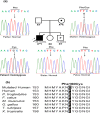Case Report: A novel hemizygous missense PDHA1 variant in a Vietnamese boy with pyruvate dehydrogenase E1-alpha deficiency
- PMID: 39720099
- PMCID: PMC11666387
- DOI: 10.3389/fped.2024.1494604
Case Report: A novel hemizygous missense PDHA1 variant in a Vietnamese boy with pyruvate dehydrogenase E1-alpha deficiency
Abstract
A pyruvate dehydrogenase complex deficiency causes a reduction in adenosine triphosphate production and energy insufficiency, leading to neurological disorders. An abnormal E1-alpha protein originating from the PDHA1 gene with pathogenic variants is unable to communicate with E1-beta for the formation of the E1 enzyme, decreasing pyruvate dehydrogenase complex activity. In this study, we report a Vietnamese boy with lethargy, severe metabolic acidosis, increased serum lactate, hyperalaninemia, lactic acidosis, and globus pallidus lesions. Whole-exome sequencing and variant filtering identified a hemizygous missense variant NM000284.4 (PDHA1): c.479T>G (p.Phe160Cys) in the patient. The variant c.479T>G caused a single nucleotide substitution on exon 5 and was predicted to be a disease-causing variant in the in silico analyses. We present the first report with a genetic analysis of a Vietnamese patient with pyruvate dehydrogenase E1-alpha deficiency (PDHAD). Sanger sequencing demonstrated that the patient inherited the variant from his mother who harbored the variant in a heterozygous state, but no PDHAD symptoms were observed in her. In addition, a prenatal test of the patient's mother revealed a fetus with a normal genotype. Furthermore, the patient's father and sister both carried a normal allele. Based on the American College of Medical Genetics criteria, the variant c.479T>G was predicted to be a likely pathogenic variant. Using the combination of the patient's genotype and phenotype, he was definitively diagnosed with pyruvate dehydrogenase E1-alpha deficiency. Our findings expand the mutational spectrum of neurological disorders and provide the scientific basis for genetic counseling for the patient's family.
Keywords: PDHA1; Vietnamese; missense variant; pyruvate dehydrogenase E1-alpha deficiency; whole-exome sequencing.
© 2024 Nguyen, Khanh, Vu, Nguyen, Tran, Lien, Van Tung, Quan, Hien, Giang, Xuan, Tao, Khoa and Nguyen.
Conflict of interest statement
The authors declare that the research was conducted in the absence of any commercial or financial relationships that could be construed as a potential conflict of interest.
Figures


Similar articles
-
Novel Synonymous and Deep Intronic Variants Causing Primary and Secondary Pyruvate Dehydrogenase Complex Deficiency.Hum Mutat. 2024 Mar 25;2024:1611838. doi: 10.1155/2024/1611838. eCollection 2024. Hum Mutat. 2024. PMID: 40225937 Free PMC article.
-
Molecular characterization of 82 patients with pyruvate dehydrogenase complex deficiency. Structural implications of novel amino acid substitutions in E1 protein.Mol Genet Metab. 2011 Dec;104(4):507-16. doi: 10.1016/j.ymgme.2011.08.008. Epub 2011 Aug 18. Mol Genet Metab. 2011. PMID: 21914562
-
[Analysis of PDHA1 gene variant in a patient with pyruvate dehydrogenase E1alpha deficiency and pyramidal tract involvement].Zhonghua Yi Xue Yi Chuan Xue Za Zhi. 2020 Jun 10;37(6):657-660. doi: 10.3760/cma.j.issn.1003-9406.2020.06.015. Zhonghua Yi Xue Yi Chuan Xue Za Zhi. 2020. PMID: 32472546 Chinese.
-
Mutations in the X-linked pyruvate dehydrogenase (E1) alpha subunit gene (PDHA1) in patients with a pyruvate dehydrogenase complex deficiency.Hum Mutat. 2000;15(3):209-19. doi: 10.1002/(SICI)1098-1004(200003)15:3<209::AID-HUMU1>3.0.CO;2-K. Hum Mutat. 2000. PMID: 10679936 Review.
-
Comparison Between Dichloroacetate and Phenylbutyrate Treatment for Pyruvate Dehydrogenase Deficiency.Br J Biomed Sci. 2022 May 19;79:10382. doi: 10.3389/bjbs.2022.10382. eCollection 2022. Br J Biomed Sci. 2022. PMID: 35996497 Free PMC article. Review.
References
-
- Ganetzky R, McCormick EM, Falk MJ. Primary Pyruvate Dehydrogenase Complex Deficiency Overview. Seattle: University of Washington; (2021). Available online at: https://www.ncbi.nlm.nih.gov/books/NBK571223/(accessed March 30, 2023). - PubMed
Publication types
LinkOut - more resources
Full Text Sources

